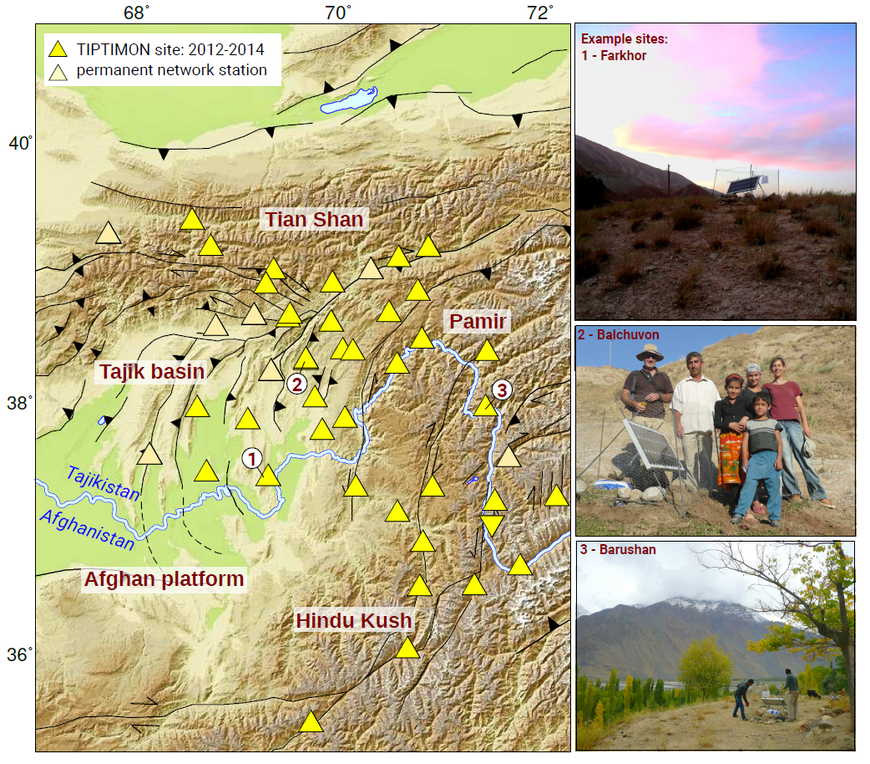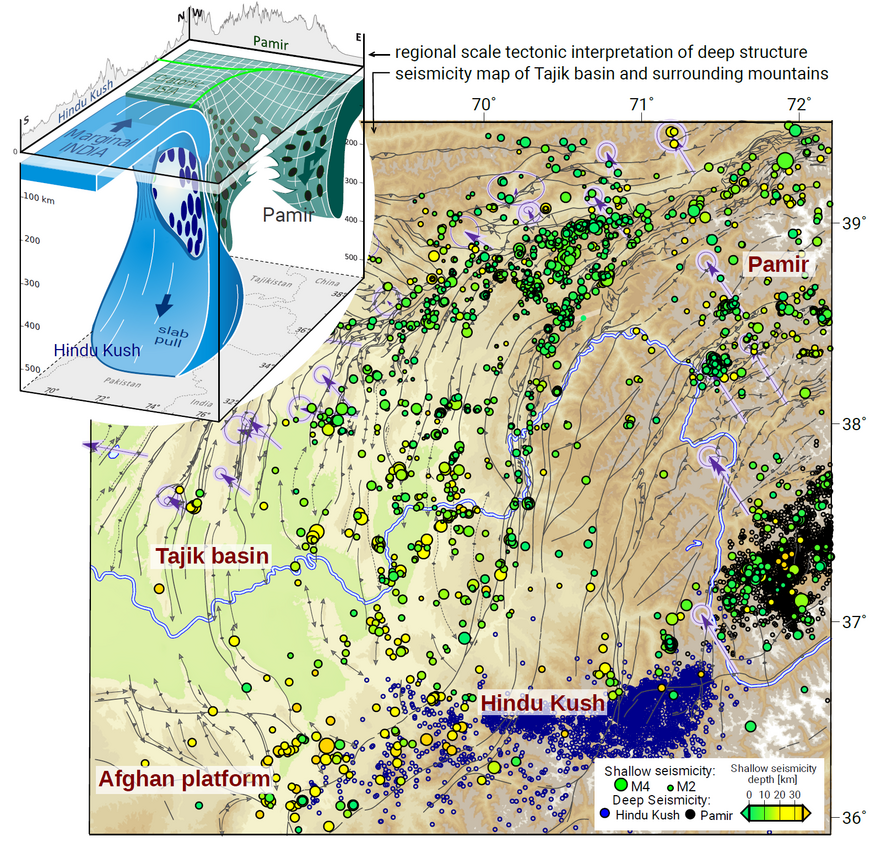Seismotectonics of the Tajik-Afghan basin and western Pamir
TIPTIMON was a research project funded by the German Federal Ministry of Education and Research (BMBF) within the CAME Programme (Central Asia - Monsoon dynamics an Geo-ecosystems).
At Section 4.1 we study the seismotectonics of the western Pamir and Tajik basin. The highly populated Tajik basin is situated between Hindu Kush in the south, Tian Shan in the north and Pamir in the east. Several major faults with various kinematics cross the basin and its margins. Tectonics are complex and the basin reacts to both northward push from India-Eurasia collision and westward escape of the Pamir. At sub-crustal depths the basin’s lithosphere is restricted by two intracontinental subduction zones beneath Pamir and Hindu Kush, which host unique intracontinental intermediate depth earthquakes. TIPTIMON aimed to understand the origin of these seismic zones and their relation to crustal tectonics.
In June 2012 a 33 seismic station network was set up (Figure 1). Using seismic tomography, two deformed lithospheric slabs of Indian and Asian origin beneath Hindu Kush and Pamir were resolved (Figure 2, inset). These slabs react differently to the forces imposed by the ongoing India-Asia collision: The Pamir slab is forced to retreat and subduct by the indenting Indian lithosphere. The entire Hindu Kush slab is in the process of break-off, producing frequent magnitude 7+ earthquakes during its final stage of tearing.
Squeezed between these intracontinental subduction zones, the Tajik basin lithosphere forms the backstop for the north-dipping Indian-slab subduction beneath the Hindu Kush, but delaminates and retreats itself west- and northward beneath the Pamir. Crustal deformation within the basin is highly partitioned (Figure 2) with transpressive strike-slip deformation dominating on the bounding faults at the basin’s northern and eastern rims. Crustal seismicity at the basin’s southern margin occurs beneath the Afghan platform, where deep crustal earthquakes likely trace the western end of the Hindu Kush subduction zone. Earthquakes within the basin dominantly align at the base of the sediments and indicate sliding along a horizontal interface. This suggests that crustal tectonics in the Pamir and Hindu Kush links with lithospheric-scale processes, whereas deformation in the basin is controlled by the westward gravitational collapse of the Pamir and the resultant basin inversion.
Research of our section in Central Asia is continued in the CATENA and Natural laboratory Central Asia projects.
Coordinators: Matthias Rosenau, Bernd Schurr (sec 4.1)
PIs: Bernd Schurr (sec. 4.1), Xiaohui Yuan (sec. 2.4), Christian Haberland (sec. 2.2)
PhD Student: Sofia-Katerina Kufner (sec. 4.1)
Funding: BMBF and GFZ Expedition fund
Project duration: 2012-2015
Main partners: Institute of Geology, Earthquake Engineering and Seismology of the Academy Science of the Republic of Tajikistan, Dushanbe, Tajikistan; Aga Khan Agency for Habitat (AKAH), Kabul, Afghanistan; Geology, TU Bergakademie Freiberg, Freiberg, Germany.
Publications:
- Kufner, S.-K., Schurr, B., Ratschbacher, L., Murodkulov, S., Abdulhameed, S., Ischuk, A., Metzger, S., and Kakar, N. (under review). Seismotectonics of the Tajik basin and surrounding mountain ranges. Tectonics.
- Kufner, S.-K., Schurr, B., Haberland, C., Zhang, Y., Saul, J., Ischuk, A., and Oimahmadov, I. (2017a). Zooming into the Hindu Kush slab break-off: A rare glimpse on the terminal stage of subduction. Earth and Planetary Science Letters, 461, 127-140.
- Kufner, S.-K., Schurr, B., Haberland, C., Zhang, Y., Saul, J., Ischuk, A., and Oimahmadov I. (2017b). Über die Deformation einer Lithosphärenplatte kurz vor der kompletten Ablösung: Ein Schnappschuss aus der Tiefe des Hindukusch. Mitteilungen der Deutschen Geophysikalischen Gesellschaft (in German). 2/2017.
- Kulikova, G., Schurr, B., Krüger, F., Brzoska, E., & Heimann, S. (2016). Source parameters of the Sarez-Pamir earthquake of 1911 February 18. Geophysical Journal International, 205(2), 1086-1098.
- Kufner, S.-K., Schurr, B., Sippl, C., Yuan, X., Ratschbacher, L., Ischuk, A., and Tilmann, F. (2016). Deep India meets deep Asia: Lithospheric indentation, delamination and break-off under Pamir and Hindu Kush (Central Asia). Earth and Planetary Science Letters, 435, 171-184.
- Kufner, S.-K. (2016). Lithospheric structure and seismotectonic setting of the Hindu Kush, the Tajik-Afghan basin and the western Pamir from analysis of local- and teleseismic data. PhD thesis, Freie Universität Berlin, 191pp.

Figure 1: Station map and example sites of the TIPTIMON seismic network. All stations within Tajikistan have broadband sensors. Stations within Afghanistan are equipped with short period instruments. Data is archived at GEOFON .

Figure 2: Results and tectonic interpretation gained from the analysis of TIPTIMON data (figures modified from Kufner et al., 2016/2017a). Large map: Seismicity distribution within the Tajik basin and surrounding mountain ranges. Purple arrows are GPS vectors relative to stable Asia. Inset: tectonic interpretation of the lithospheric scale structure showing the complex interaction of Indian and Asian lithosphere.



